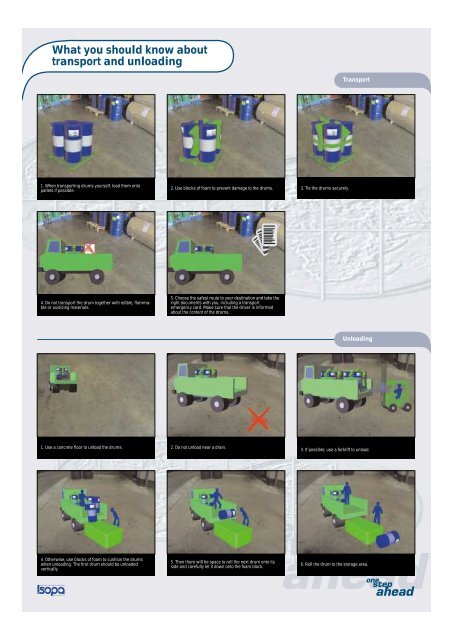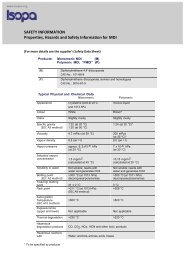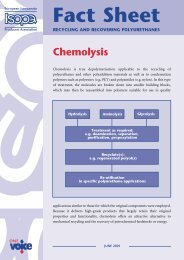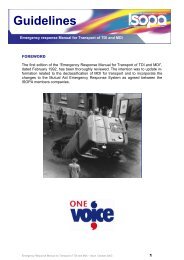What you should know about transport and unloading - Isopa
What you should know about transport and unloading - Isopa
What you should know about transport and unloading - Isopa
You also want an ePaper? Increase the reach of your titles
YUMPU automatically turns print PDFs into web optimized ePapers that Google loves.
<strong>What</strong> <strong>you</strong> <strong>should</strong> <strong>know</strong> <strong>about</strong><br />
<strong>transport</strong> <strong>and</strong> <strong>unloading</strong><br />
Transport<br />
1. When <strong>transport</strong>ing drums <strong>you</strong>rself, load them onto<br />
pallets if possible.<br />
2. Use blocks of foam to prevent damage to the drums.<br />
3. Tie the drums securely.<br />
4. Do not <strong>transport</strong> the drum together with edible, flammable<br />
or oxidizing materials.<br />
5. Choose the safest route to <strong>you</strong>r destination <strong>and</strong> take the<br />
right documents with <strong>you</strong>, including a <strong>transport</strong><br />
emergency card. Make sure that the driver is informed<br />
<strong>about</strong> the content of the drums.<br />
Unloading<br />
1. Use a concrete floor to unload the drums.<br />
2. Do not unload near a drain.<br />
3. If possible, use a forklift to unload.<br />
4. Otherwise, use blocks of foam to cushion the drums<br />
when <strong>unloading</strong>. The first drum <strong>should</strong> be unloaded<br />
vertically.<br />
5. Then there will be space to roll the next drum onto its<br />
side <strong>and</strong> carefully let it down onto the foam block.<br />
6. Roll the drum to the storage area.
<strong>What</strong> <strong>you</strong> <strong>should</strong> <strong>know</strong> <strong>about</strong> storage<br />
<strong>and</strong> drum decontamination<br />
Storage<br />
1. The temperature in the storage area must be between<br />
15°C <strong>and</strong> 40°C. The storage area must be well ventilated.<br />
2. A fire extinguisher must be readily available in the storage<br />
area. If possible, this <strong>should</strong> be a foam extinguisher.<br />
3. Do not stack the drums higher than three levels.<br />
4. Leave enough space between the stacks for visual<br />
inspection.<br />
5. Do not leave the drums in a horizontal position.<br />
Make sure each drum is resting on its base.<br />
Drum decontamination<br />
1. Emptying <strong>and</strong> decontamination of drums must be<br />
carried out in a restricted area. The drum must be<br />
drip-free. Product labels <strong>should</strong> NOT be removed.<br />
2. Wear a breathing mask, goggles, boots <strong>and</strong> long sleeves<br />
while carefully putting the decontamination solution into<br />
the drum.<br />
3. Close the drum completely.<br />
4. Roll the drum at least four times so that the<br />
decontaminant reaches all parts of the drum.<br />
5. Slightly open bung to release the pressure. Leave the<br />
drum like this for at least two days.
<strong>What</strong> <strong>you</strong> <strong>should</strong> <strong>know</strong> <strong>about</strong> working<br />
with TDI (toluene diisocyanates)<br />
Working with TDI<br />
1. Make sure that fire extinguishers, tap water, hoses <strong>and</strong><br />
shower bath are readily accessible.<br />
2. Make sure that ventilation is working well in the production<br />
<strong>and</strong> storage areas.<br />
3. Make sure the TDI is at the right temperature.<br />
4. While working on the production line, wear a breathing<br />
mask, goggles, gloves, long sleeves <strong>and</strong> boots.<br />
5. Use a pump to empty the drums.<br />
6. During production, take regular measurements of<br />
TDI concentrations in the air. If <strong>you</strong> inhale high concentrations<br />
immediately seek medical attention.<br />
7. When storing foam, make sure there is enough space<br />
between each block because high temperatures can<br />
develop. Regularly check the temperature of the foam.<br />
8. Keep storage areas free of scrap foam <strong>and</strong> other flammable<br />
material.
<strong>What</strong> <strong>you</strong> <strong>should</strong> <strong>know</strong> <strong>about</strong><br />
a minor spill<br />
A minor spill<br />
1. A minor spillage can be dealt with on the spot.<br />
2. Take positive action. Inform the relevant members of the<br />
staff <strong>and</strong> evacuate the area.<br />
3. Put on full protective clothing, including coveralls, boots,<br />
goggles, gloves <strong>and</strong> breathing mask.<br />
4. Roll the leaking drum to prevent further spillage <strong>and</strong><br />
seal it with tape.<br />
5. Roll the damaged drum into the oversized drum, turn it<br />
onto its base <strong>and</strong> seal it loosely.<br />
6. Prevent spreading by covering the spillage with s<strong>and</strong> or<br />
other absorbent material.<br />
7. After putting s<strong>and</strong> or other absorbent material on the spillage,<br />
put decontamination solution on the affected area <strong>and</strong><br />
then leave it for <strong>about</strong> 30 minutes. The main components of<br />
decontamination solution are water, soap <strong>and</strong> glycol.<br />
8. Place the absorbent material into a waste container or<br />
an empty drum using a shovel.<br />
9. Clean the immediate area around the spillage with<br />
decontamination solution <strong>and</strong> wash down with water.<br />
10. The decontaminated absorbent must be <strong>transport</strong>ed to<br />
a safe place <strong>and</strong> disposed of safely.<br />
11. Rinse <strong>you</strong>rself with water. When there is a major spill,<br />
or a spill in a public area, call the emergency number of<br />
<strong>you</strong>r supplier or distributor.
















